Online Relinquishments of Dogs and Cats in Australia
Abstract
:Simple Summary
Abstract
1. Introduction
2. Materials and Methods
2.1. Extraction of Data
2.2. Analysis of Relinquishment Ads
2.3. Surveys of Owners Who Had Relinquished Dogs or Cats
2.4. Statistical Tests
3. Results
3.1. Dogs on Gumtree
3.2. Cats on Gumtree
3.3. Interviews
4. Discussion
5. Conclusions
Acknowledgments
Author Contributions
Conflicts of Interest
References
- Animal Medicines Australia. Pet Ownership in Australia 2016. Available online: http://animalmedicinesaustralia.org.au/wp-content/uploads/2016/11/AMA_Pet-Ownership-in-Australia-2016-Report_sml.pdf (accessed on 11 December 2017).
- Chua, D.; Rand, J.; Morton, J. Surrendered and stray dogs in Australia—Estimation of numbers entering municipal pounds, shelters and rescue groups and their outcomes. Animals 2017, 7, 50. [Google Scholar] [CrossRef] [PubMed]
- Clark, C.C.; Gruffydd-Jones, T.; Murray, J.K. Number of cats and dogs in UK welfare organisations. Vet. Rec. 2012, 170, 493. [Google Scholar] [CrossRef] [PubMed]
- RSPCA Australia National Statistics 2015–2016. Available online: https://www.rspca.org.au/sites/default/files/RSPCA%20Australia%20Annual%20Statistics%202015-2016%20.pdf (accessed on 12 November 2017).
- Hwang, B.R.; Ah Lee, Y.; Joon Kim, H.; Ju Cho, Y.; Jhun, H.; Cheol Kim, S.; Seon Bae, J.; Soo Han, J. Survey on the status of abandoned animals in Seoul City, 2013. GJMR G Vet. Sci. Vet. Med. 2016, 16, 1–9. [Google Scholar]
- New, J.C., Jr.; Kelch, W.J.; Hutchison, J.M.; Salman, M.D.; King, M.; Scarlett, J.M.; Kass, P.H. Birth and death rate estimates of cats and dogs in U.S. households and related factors. J. Appl. Anim. Welf. Sci. 2004, 7, 229–241. [Google Scholar] [PubMed]
- Australian Companion Animal Council. Contribution of the Pet Care Industry to the Australian Economy, 7th ed.; Rockwell Communications: Kew East, VIC, Australia, 2010. [Google Scholar]
- Stavisky, J.; Brennan, M.L.; Downes, M.; Dean, R. Demographics and economic burden of un-owned cats and dogs in the UK: Results of a 2010 census. BMC Vet. Res. 2012, 8, 163. [Google Scholar] [CrossRef] [PubMed]
- House of Lords 8 February 2012. Available online: http://www.publications.parliament.uk/pa/ld201212/ldhansrd/text/120208-0001.htm#12020840000842 (accessed on 11 December 2017).
- Lambert, K.; Coe, J.; Niel, L.; Dewey, C.; Sargeant, J.M. A systematic review and meta-analysis of the proportion of dogs surrendered for dog-related and owner-related reasons. Prev. Vet. Med. 2015, 118, 148–160. [Google Scholar] [CrossRef] [PubMed]
- Shore, E.R.; Petersen, C.L.; Douglas, D.K. Moving as a reason for pet relinquishment: A closer look. J. Appl. Anim. Welf. Sci. 2003, 6, 39–52. [Google Scholar] [CrossRef] [PubMed]
- Reeve, C.L.; Rogelberg, S.G.; Spitzmuller, D.; DiGiacomo, N. The caring-killing paradox: Euthanasia-related strain among animal-shelter workers. J. Appl. Soc. Psychol. 2005, 35, 119–143. [Google Scholar] [CrossRef]
- Anderson, K.A.; Brandt, J.C.; Lord, L.K.; Miles, E.A. Euthanasia in animal shelters: Management’s perspective on staff reactions and support programs. Anthrozoos 2013, 26, 569. [Google Scholar] [CrossRef]
- Rogelberg, S.G.; Reeve, C.L.; Spitzmuller, C.; DiGiacomo, N.; Clark, O.L.; Teeter, L.; Walker, A.G.; Starling, P.G.; Carter, N.T. Impact of euthanasia rates, euthanasia practices, and human resource practices on employee turnover in animal shelters. J. Am. Vet. Med. Assoc. 2007, 230, 713–719. [Google Scholar] [CrossRef] [PubMed]
- German, A. The extent and implications of unwanted cats and dogs. Vet. Rec. 2012, 170, 491–492. [Google Scholar] [CrossRef] [PubMed]
- Cozzi, A.; Gazzano, A.; Mariti, C.; Notari, L.; Ducci, M.; Martelli, F. Behavioural changes in sheltered dogs. Ann. Fac. Med. Vet. Pisa 2007, 60, 241–258. [Google Scholar]
- Schorr-Evans, E.M.; Poland, A.; Johnson, W.E.; Pedersen, N.C. An epizootic of highly virulent feline calicivirus disease in a hospital setting in New England. J. Feline Med. Surg. 2003, 5, 217–226. [Google Scholar] [CrossRef]
- Pesavento, P.A.; Hurley, K.F.; Bannasch, M.J.; Artiushin, S.; Timoney, J.F. A clonal outbreak of acute fatal hemorrhagic pneumonia in intensively housed (shelter) dogs caused by Streptococcus equi subsp. zooepidemicus. Vet. Pathol. 2008, 45, 51–53. [Google Scholar] [CrossRef] [PubMed]
- Alberthsen, C.; Rand, J.; Morton, J.; Bennett, P.; Paterson, M.; Vankan, D. Numbers and characteristics of cats admitted to Royal Society for the Prevention of Cruelty to Animals (RSPCA) shelters in Australia and reasons for surrender. Animals 2016, 6, 23. [Google Scholar] [CrossRef] [PubMed]
- Dolan, E.D.; Scotto, J.; Slater, M.; Weiss, E. Risk factors for dog relinquishment to a Los Angeles municipal animal shelter. Animals 2015, 5, 1311–1328. [Google Scholar] [CrossRef] [PubMed]
- Rent Fair Victoria. Available online: https://www.vic.gov.au/rentfair/pets-are-welcome.html (accessed on 11 December 2017).
- Gumtree. Available online: https://www.gumtree.com.au (accessed on 7 February 2018).
- Trading Post. Available online: https://www.tradingpost.com.au (accessed on 7 February 2018).
- DogzOnline. Available online: https://www.dogzonline.com.au (accessed on 7 February 2018).
- Voris, H.C.; Wittum, T.E.; Rajala-Schultz, P.J.; Lord, L.K. Characterization of advertisements for puppies sold online: Determinants of cost and a comparison with parent club breeders. Prev. Vet. Med. 2011, 100, 200–209. [Google Scholar] [CrossRef] [PubMed]
- PetRescue. Available online: https://www.petrescue.com.au (accessed on 7 February 2018).
- English Oxford Living Dictionaries. Available online: https://en.oxforddictionaries.com/definition/relinquish (accessed on 7 February 2018).
- Australian Bureau of Statistics. 3101.0—Australian Demographic Statistics, Mart 2016. Available online: http://www.abs.gov.au/AUSSTATS/abs@.nsf/allprimarymainfeatures/3ADCB8E8492A9156CA25808900122529?opendocument (accessed on 7 February 2018).
- Hemy, M.; Rand, J.; Morton, J.; Paterson, M. Characteristics and outcomes of dogs admitted into Queensland RSPCA shelters. Animals 2017, 7, 67. [Google Scholar] [CrossRef] [PubMed]
- EU Dog & Cat Alliance®. Belgium Launches New Animal Welfare Initiative to Tackle the High Risk Online Sale of Pets. 2017. Available online: https://www.dogandcatwelfare.eu/news/belgium-launches-new-animal-welfare-initiative-tac/ (accessed on 11 December 2017).
- EU Dog & Cat Alliance®. Online Sale of Pets: What’s the Cost? Available online: https://www.dogandcatwelfare.eu/news/online-sale-pets-whats-cost/ (accessed on 11 December 2017).
- Better Business Bureau (R). Puppy Scams: How Fake Online Pet Sellers Steal from Unsuspecting Pet Buyers. A BBB Study. Available online: https://www.bbb.org/en/us/article/investigations/14214-puppy-scams-how-fake-online-pet-sellers-steal-from-unsuspecting-pet-buyers-a-bbb-study (accessed on 11 December 2017).
- Patronek, G.J.; Bradley, J. No better than flipping a coin: Reconsidering canine behavior evaluations in animal shelters. J. Vet. Behav. Clinic. Appl. Res. 2016, 15, 66–77. [Google Scholar] [CrossRef]
- New, J.C.J.; Salman, M.D.; King, M.; Scarlett, J.M.; Kase, B.A.; Hutchison, J.M. Characteristics of shelter-relinquished animals and their owners compared with animals and their owners in U.S. Pet-owning households. J. Appl. Anim. Welf. Sci. 2000, 3, 179–201. [Google Scholar] [CrossRef]
- Weiss, E.; Gramann, S. A comparison of attachment levels of adopters of cats: Fee-based adoptions versus free adoptions. J. Appl. Anim. Welf. Sci. 2009, 12, 360–370. [Google Scholar] [CrossRef] [PubMed]
- RSPCA Australia KnowledgeBase. Available online: http://kb.rspca.org.au/Is-hunting-feral-pigs-with-dogs-legal-in-Australia_295.html (accessed on 11 December 2017).
- Australian National Kennel Council. Available online: http://ankc.org.au/ (accessed on 11 December 2017).
- Arluke, A.; Patronek, G.J.; Lockwood, R.; Cardona, A. Animal hoarding. In The Palgrave International Handbook of Animal Abuse Studies; Maher, J., Pierpoint, H., Bierne, P., Eds.; Palgrave Macmillan: London, UK, 2017. [Google Scholar]
- Mohan-Gibbons, H.; Weiss, E.; Garrison, L.; Allison, M. Evaluation of a novel dog adoption program in two US communities. PLoS ONE 2014, 9, e91959. [Google Scholar] [CrossRef] [PubMed]
- Ethical Decision-Making and Internet Research: Recommendations from the AOIR Ethics Committee Approved by the Ethics Working Committee (Version 2.0), 08/2012. Available online: https://aoir.org/reports/ethics2.pdf (accessed on 8 January 2018).
- Izuma, K. The social neuroscience of reputation. Neurosci. Res. 2012, 72, 283–288. [Google Scholar] [CrossRef] [PubMed]
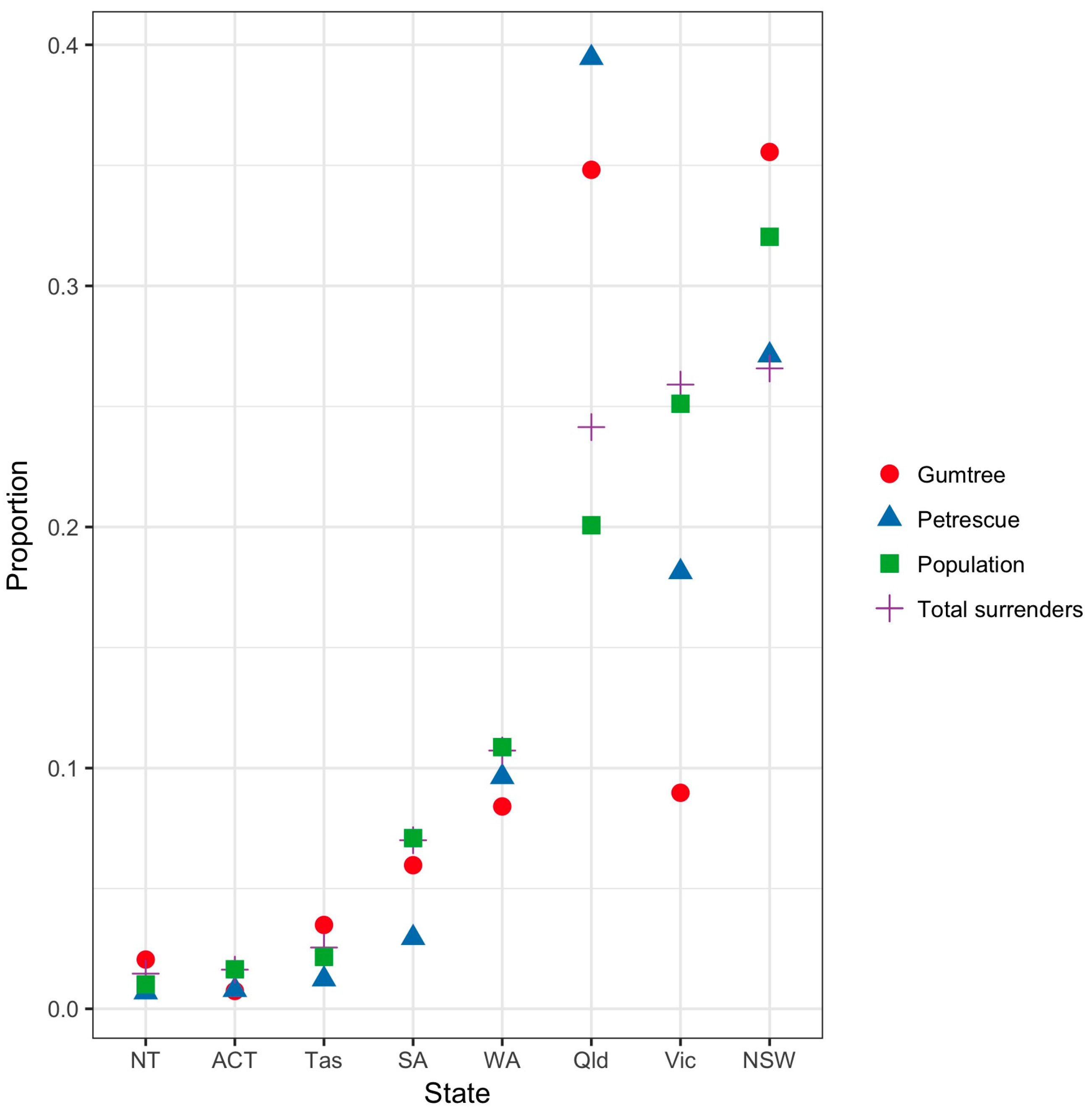
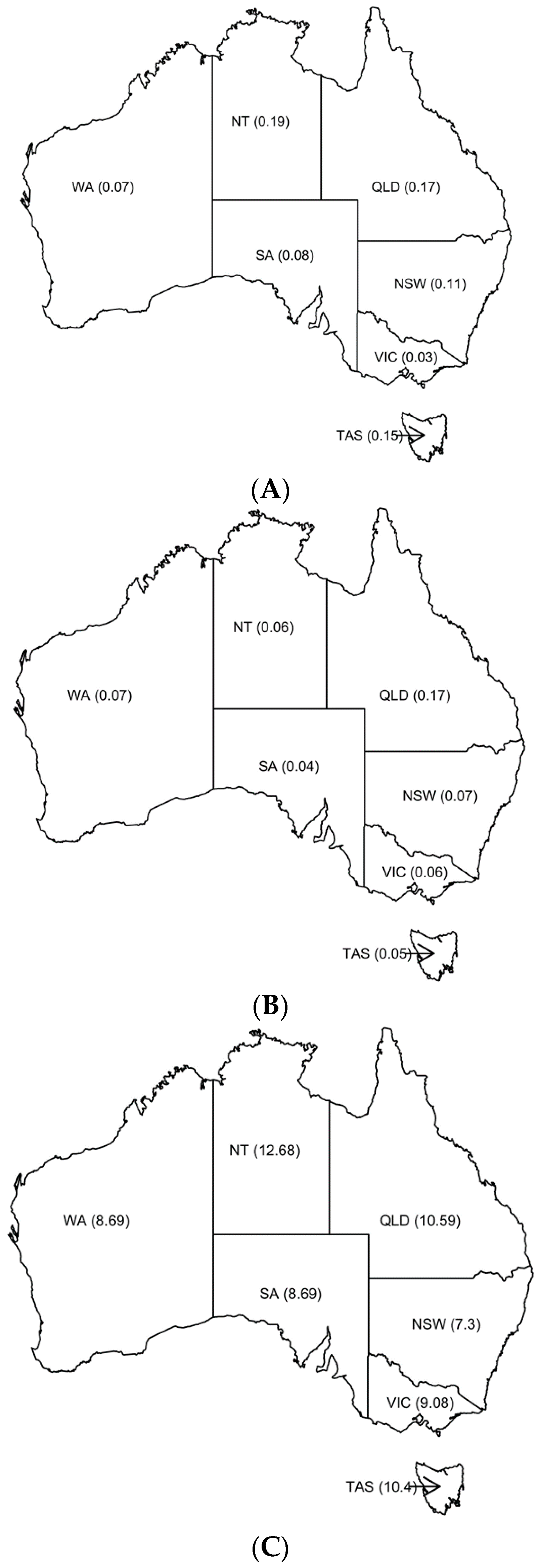
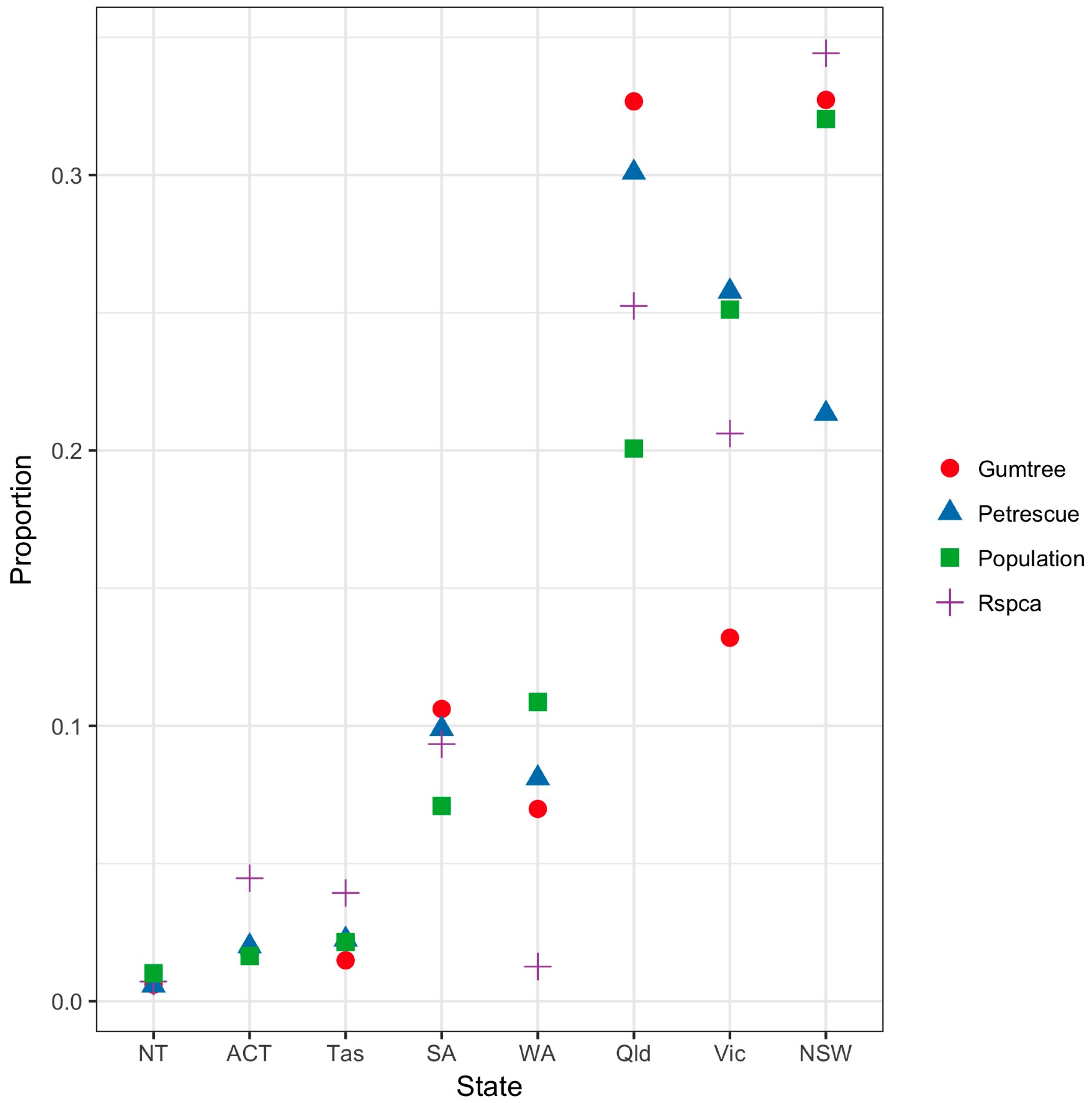
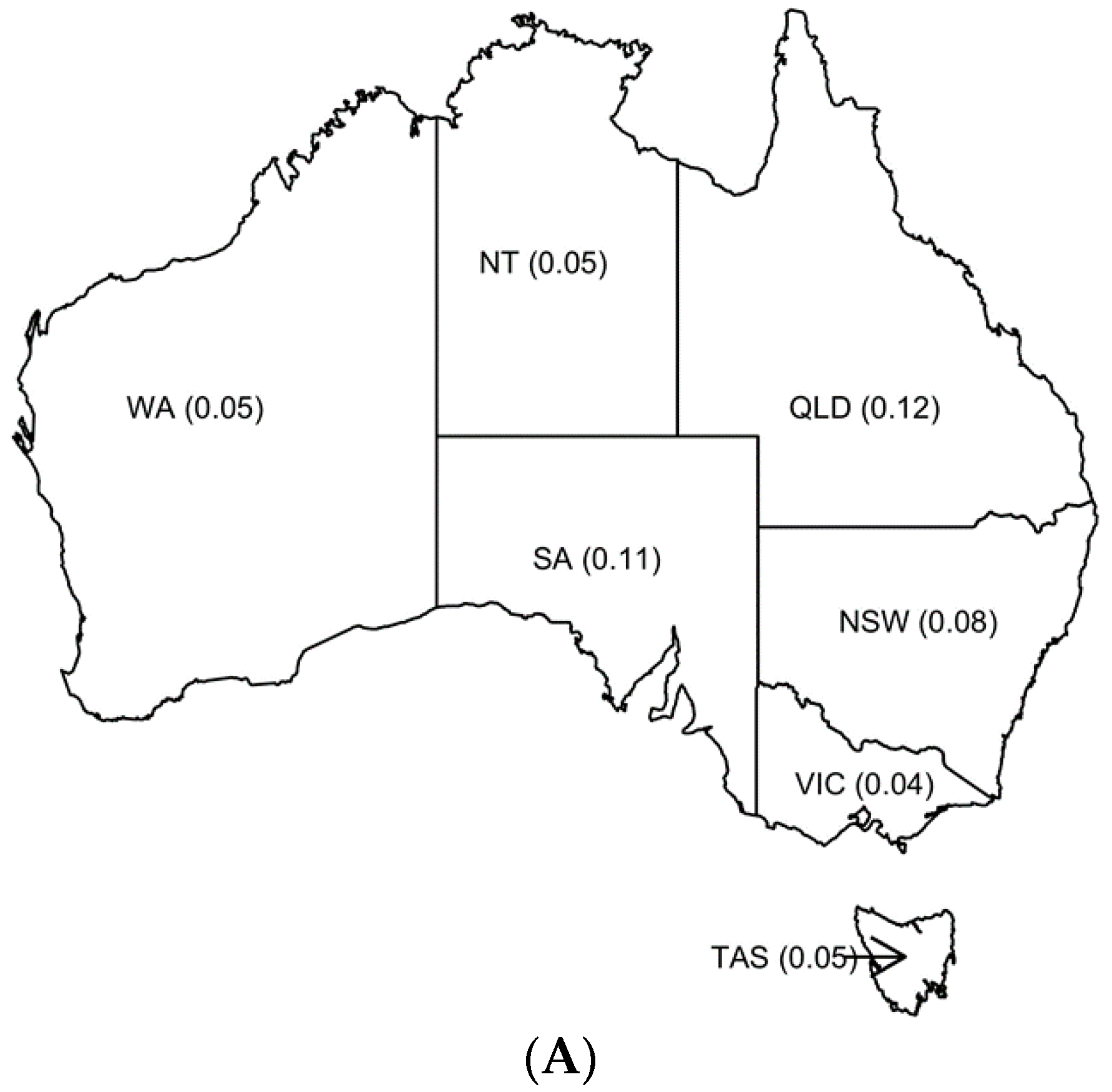
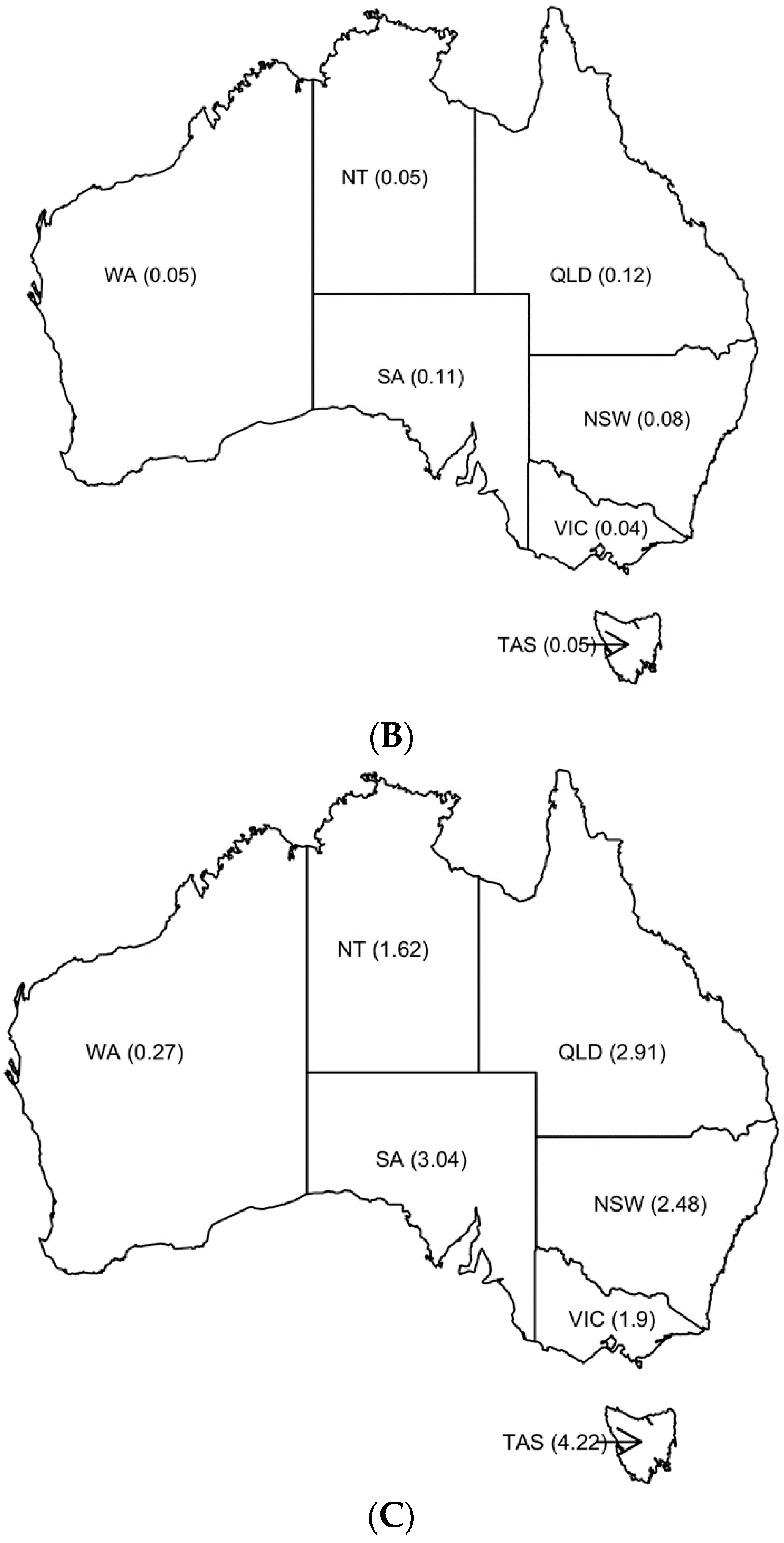
| Gumtree | PetRescue | |||||||
|---|---|---|---|---|---|---|---|---|
| # 1 | Total | Pure | Cross | # 1 | Total | Pure | Cross | |
| Staffordshire Terrier | 1 | 325 (12.3) | 163 (6.1) | 162 (6.1) | 1 | 234 (11.5) | 48 (9.9) | 186 (12.1) |
| Kelpie | 2 | 219 (8.3) | 119 (4.5) | 100 (3.8) | 2 | 181 (8.9) | 40 (8.3) | 141 (9.1) |
| American Staffordshire Terrier | 3 | 182 (6.9) | 132 (5) | 50 (1.9) | 3 | 91 (4.5) | 14 (2.9) | 77 (5) |
| Bull Arab | 4 | 135 (5.1) | 37 (1.4) | 98 (3.7) | 7 | 74 (3.7) | 7 (1.4) | 67 (4.3) |
| Border Collie | 5 | 120 (4.5) | 64 (2.4) | 56 (2.1) | 5 | 85 (4.2) | 11 (2.3) | 74 (4.8) |
| Mastiff | 6 | 103 (3.9) | 28 (1.1) | 75 (2.8) | 9 | 64 (3.2) | 4 (0.8) | 60 (3.9) |
| Rottweiler | 7 | 101 (3.8) | 73 (2.8) | 28 (1) | 15 | 37 (1.8) | 7 (1.4) | 30 (1.9) |
| German Shepherd | 8 | 98 (3.7) | 74 (2.8) | 24 (0.9) | 12 | 50 (2.5) | 24 (5) | 26 (1.7) |
| Siberian Husky | 9 | 87 (3.3) | 66 (2.5) | 21 (0.8) | 19 | 25 (1.2) | 18 (3.7) | 7 (0.5) |
| Great Dane | 10 | 77 (2.9) | 26 (1) | 51 (1.9) | 13 | 50 (2.5) | 10 (2.1) | 40 (2.6) |
| Labrador | 11 | 75 (2.8) | 34 (1.3) | 41 (1.6) | 10 | 64 (3.2) | 17 (3.5) | 47 (3.6) |
| Cattledog | 12 | 71 (2.7) | 45 (1.7) | 26 (1) | 6 | 84 (4.1) | 9 (1.9) | 75 (4.9) |
| Bulldog | 13 | 62 (2.3) | 52 (2) | 10 (0.4) | N | 0 | 0 | 0 |
| Chihuahua | 14 | 55 (2.1) | 39 (1.5) | 16 (0.6) | 16 | 30 (1.5) | 8 (1.7) | 22 (1.4) |
| Jack Russell Terrier | 15 | 53 (2) | 26 (1) | 27 (1) | 8 | 74 (3.7) | 16 (3.3) | 58 (3.8) |
| American Bulldog | 16 | 42 (1.6) | 27 (1) | 15 (0.6) | 21 | 20 (1) | 1 (0.2) | 19 (1.2) |
| Maltese | 17 | 41 (1.6) | 12 (0.5) | 29 (1.1) | 11 | 63 (3.1) | 9 (1.9) | 54 (3.5) |
| Bull Terrier | 18 | 38 (1.4) | 19 (0.7) | 19 (0.7) | 25 | 13 (0.6) | 6 (1.2) | 7 (0.5) |
| Shar Pei | 19 | 35 (1.3) | 18 (0.7) | 17 (0.6) | 22 | 20 (1) | 3 (0.6) | 17 (1.1) |
| Fox Terrier | 20 | 35 (1.3) | 21 (0.8) | 14 (0.5) | 18 | 28 (1.4) | 5 (1) | 23 (1.5) |
| Pomeranian | 21 | 31 (1.2) | 23 (0.9) | 8 (0.3) | 23 | 18 (0.9) | 4 (0.8) | 14 (0.9) |
| Malamute | 22 | 27 (1) | 21 (0.8) | 6 (0.2) | 26 | 13 (0.6) | 6 (1.2) | 7 (0.5) |
| Blue Heeler | 23 | 25 (0.9) | 12 (0.5) | 13 (0.5) | 27 | 5 (0.2) | 1 (0.2) | 4 (0.3) |
| Greyhound | 24 | 25 (0.9) | 23 (0.9) | 2 (0.1) | 3 | 109 (5.4) | 98 (20.2) | 11 (0.7) |
| Rhodesian Ridgeback | 25 | 24 (0.9) | 5 (0.2) | 19 (0.7) | 17 | 30 (1.5) | 0 | 30 (1.9) |
| Maremma | 26 | 20 (0.7) | 17 (0.6) | 3 (0.1) | 28 | 4 (0.2) | 1 (0.2) | 3 (0.2) |
| Irish Wolfhound | 27 | 20 (0.7) | 2 (0.1) | 18 (0.7) | 24 | 14 (0.7) | 1 (0.2) | 13 (0.8) |
| Poodle | 28 | 19 (0.7) | 15 (0.6) | 4 (0.2) | 20 | 23 (1.1) | 10 (2.1) | 13 (0.8) |
| Total | 2640 (100) | 1357 (51.4) | 1180 (44.7) | 2027 (100) | 484 (23.8) | 1543 (75.8) | ||
| Age Range | N (%) | Price Range (AUS $) | N (%) |
|---|---|---|---|
| Up to 16 weeks | 20 (0.8) | 0 | 575 (23.1) |
| 16 weeks to 6 months | 131 (5) | 1–499 | 1181 (47.4) |
| 6 months to 1 year | 680 (26.1) | 500–999 | 480 (19.3) |
| 1 to 2 years | 832 (32) | 1000–1999 | 187 (7.5) |
| 2 to 5 years | 679 (26.1) | 2000–2999 | 44 (1.8) |
| >5 years | 260 (10) | 3000–7000 | 26 (1) |
| Total | 2602 (100) | Total | 2493 (100) |
| $0 N (%) | $1–499 N (%) | >$500 N (%) | |
|---|---|---|---|
| NSW | 189 (23.2) | 420 (50.2) | 217 (26.6) |
| Qld | 276 (34.5) | 331 (41.4) | 192 (24) |
| Vic | 51 (24.8) | 57 (27.7) | 98 (47.6) |
| WA | 43 (22.3) | 79 (40.9) | 71 (36.8) |
| SA | 39 (28.5) | 64 (46.7) | 34 (24.8) |
| Tas | 24 (30) | 43 (53.8) | 13 (16.3) |
| NT | 15 (31.9) | 22 (46.8) | 10 (21.3) |
| Total | 637 | 1006 | 635 |
| Gumtree | PetRescue | |||||||
|---|---|---|---|---|---|---|---|---|
| # 1 | Total | Pure | Cross | # | Total | Pure | Cross | |
| Ragdoll | 1 | 148 | 116 | 32 | 4 | 30 | 24 | 6 |
| DSH | 2 | 81 | 0 | 81 | 1 | 1894 | 0 | 1894 |
| Bengal | 3 | 37 | 28 | 9 | 12 | 2 | 0 | 2 |
| Persian | 4 | 32 | 12 | 20 | 8 | 8 | 5 | 3 |
| Siamese | 5 | 29 | 19 | 10 | 5 | 16 | 15 | 1 |
| Russian Blue | 6 | 26 | 14 | 12 | 6 | 12 | 12 | 0 |
| Burmese | 7 | 24 | 19 | 5 | 8 | 8 | 8 | 0 |
| British Shorthair | 8 | 16 | 15 | 1 | 9 | 6 | 5 | 1 |
| Manx | 9 | 14 | 11 | 3 | 7 | 9 | 9 | 0 |
| Birman | 10 | 9 | 9 | 0 | 10 | 5 | 5 | 0 |
| Himalayan | 11 | 9 | 7 | 2 | N | 0 | 0 | 0 |
| Devon Rex | 12 | 9 | 7 | 2 | N | 0 | 0 | 0 |
| Oriental | 13 | 8 | 5 | 3 | 7 | 9 | 4 | 5 |
| Tonkinese | 14 | 8 | 6 | 2 | 11 | 3 | 2 | 1 |
| Domestic Medium Hair | 15 | 7 | 0 | 7 | 2 | 375 | 0 | 375 |
| Maine Coon | 16 | 5 | 5 | 0 | 12 | 2 | 2 | 0 |
| Domestic Long Hair | 17 | 4 | 0 | 4 | 3 | 38 | 0 | 38 |
| Chinchilla | 18 | 4 | 4 | 0 | 13 | 1 | 1 | 0 |
| Sphynx | 19 | 4 | 3 | 1 | N | 0 | 0 | 0 |
| Snowshoe | 20 | 0 | 0 | 0 | 11 | 3 | 2 | 1 |
| Australian Mist | 21 | 0 | 0 | 0 | 10 | 5 | 1 | 4 |
| Total | 508 | 310 | 198 | 2426 | 95 | 2331 | ||
| Age Range | N (%) | Price Range (AUS $) | N (%) |
|---|---|---|---|
| Up to 16 weeks | 492 (23.6) | 0 | 1298 (62) |
| 16 weeks to 6 months | 414 (19.9) | 1–499 | 617 (29.5) |
| 6 months to 1 year | 201 (9.7) | 500–999 | 73 (3.5) |
| 1 to 2 years | 373 (17.9) | 1000–1999 | 13 (0.6) |
| 2 to 5 years | 391 (18.8) | 2000–2999 | 2 (0.1) |
| >5 years | 211 (10.1) | ||
| Total | 2082 (100) | Total | 2003 (100) |
| $0 N (%) | $1–499 N (%) | >$500 N (%) | |
|---|---|---|---|
| New South Wales | 356 (62.2) | 190 (33.2) | 26 (4.5) |
| Queensland | 366 (64.3) | 183 (32.2) | 20 (3.5) |
| Victoria | 178 (77.1) | 36 (15.6) | 17 (7.4) |
| Western Australia | 65 (53.7) | 50 (41.3) | 6 (5) |
| South Australia | 125 (67.2) | 56 (30.1) | 5 (2.7) |
| Total | 1090 (64.9) | 515 (30.7) | 74 (4.4) |
| Age (yrs) | Sex | Breed | Neut. 1 | MC2 | Health | Behav. 3 | Original Source |
|---|---|---|---|---|---|---|---|
| Dogs | |||||||
| 1 | M | Pug x Jack Russell Terrier | NS | NS | NS | NS | Gumtree (rescue) |
| 4 | F | Greyhound | No | Yes | NS | NS | NS |
| 1 | F | Bull Mastiff X | No | Yes | 5 | NS | Gumtree |
| 7 | F | Siberian Husky | Yes | Yes | 4 | 3–3.5 | Friend as puppy |
| 6 | M/F | Maltese/Maltese X Pomeranian | Yes | Yes | 4 & 5 | 5 & 5 | TradingPost |
| NS | M/F | Beagle | Yes | NS | 5 & 5 | 5 & 5 | Gumtree (rescue) |
| 4.5 | M | Jack Russell | Yes | Yes | 5 | 3 | Registered breeder |
| 1.5 | M | American Staffordshire Terrier | Yes | Yes | 5 | 5 | Unregistered breeder |
| Cats | |||||||
| 1 | M | Ragdoll X | Yes | Yes | 5 | 5 | Gumtree |
| 0.33 | F | NS | No | Yes | NS | Gumtree | |
| 4.5 | M | DSH | Yes | Yes | 5 | 2 | Family litter |
| 3 | M | British Shorthair | Yes | Yes | 5 | 5 | NS |
| 2 | M | DSH | Yes | No | 5 | NS | Family with 2 Ragdolls |
| 0.92 | M | Ragdoll | Yes | Yes | 5 | 3 | Family |
| NS | NS | DSH | NS | NS | NS | NS | Strays |
| Dogs | N | Cats | N |
|---|---|---|---|
| Rescue | 2 | Dog/cat not getting on | 3 |
| Behaviour | 2 | Moving | 2 |
| Dog injury (working dog) | 1 | Rescue | 1 |
| Own health | 1 | Allergy | 1 |
| Money | 1 | Expecting a baby | 1 |
| Relationship breakdown | 1 | Too many pets | 1 |
| Moving | 1 | Time | 1 |
| Time | 1 |
| Dogs | N | Cats | N |
|---|---|---|---|
| Shelters full | 4 | Got the animal on gumtree | 2 |
| To see/interview the new owner | 2 | Use gumtree for other things | 2 |
| Lack of knowledge of shelters | 1 | To see and interview the new owner | 2 |
| It worked before | 1 | It worked before | 1 |
| Shelter is last resort | 1 | Shelter is last resort | 1 |
| Immediate posting and quick response | 1 | Would be put down at a shelter | 1 |
| Would be put down at a shelter | 1 | Shelter too hard on pet | 1 |
| Don't drive so can’t get to shelter | 1 |
© 2018 by the authors. Licensee MDPI, Basel, Switzerland. This article is an open access article distributed under the terms and conditions of the Creative Commons Attribution (CC BY) license (http://creativecommons.org/licenses/by/4.0/).
Share and Cite
Hazel, S.J.; Jenvey, C.J.; Tuke, J. Online Relinquishments of Dogs and Cats in Australia. Animals 2018, 8, 25. https://doi.org/10.3390/ani8020025
Hazel SJ, Jenvey CJ, Tuke J. Online Relinquishments of Dogs and Cats in Australia. Animals. 2018; 8(2):25. https://doi.org/10.3390/ani8020025
Chicago/Turabian StyleHazel, Susan J., Caitlin J. Jenvey, and Jonathan Tuke. 2018. "Online Relinquishments of Dogs and Cats in Australia" Animals 8, no. 2: 25. https://doi.org/10.3390/ani8020025
APA StyleHazel, S. J., Jenvey, C. J., & Tuke, J. (2018). Online Relinquishments of Dogs and Cats in Australia. Animals, 8(2), 25. https://doi.org/10.3390/ani8020025





